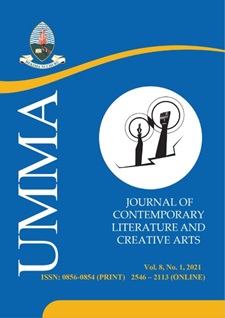Sanaa Blast Festival as Youth’s Space for Creating Futures
Voices from the University of Dar es Salaam Graduates in Tanzania
Abstract
This article examines the impact of the Sanaa Blast Festival in creating youth futures. Sanaa is a Kiswahili term that means art. The annual Sanaa Blast Festival that the Department of Creative Arts of the University of Dar es Salaam organises is a prime event targeting the optimisation of the tapping of university students’ talents. The chief organisers of the festival are students themselves under the consultation of their instructors. Since its inception, the festival has helped transform the lives of youth graduates in diverse ways. However, these impacts often go unnoticed as no study has focused on this event. Against this backdrop, this study was conducted and used both secondary and primary data. Primary data were gathered through interview methods, mainly in-depth key informants and focus groups. Secondary data was utilised to locate theories, identify gaps, and back up findings gathered for this study. Using the tenet of the third space, this article argues that the Sanaa Blast Festival connects youth to the creative industry and gives them access to creative firms and people who later connect them to diverse opportunities, mostly jobs, internships, and networks. Becoming famous is a benefit that the Sanaa Blast Festival engenders to the graduates. Although the Sanaa Blast impacts the lives of youth optimistically, its survival remains doubtful because of the interplay of factors, such as insufficient recognition of the festival coupled with a limited budget, which presents persistent hurdles jeopardising the sustainability of the festival. Thus, the government, private companies, art stakeholders, and alumni must support the festival since it exposes youth to connections with companies and influential people in the creative industry.
Keywords:
Sanaa Blast Festival, cultural festival, youth employment, Creative Arts, UDSM https://dx.doi.org/10.56279/ummaj.v11i2.10
Downloads
Published
Issue
Section
License
Copyright (c) 2024 Creative Commons

This work is licensed under a Creative Commons Attribution-NoDerivatives 4.0 International License.
- Authors retain copyright and grant the journal right of first publication with the work simultaneously licensed under a Creative Commons Attribution License that allows others to share the work with an acknowledgement of the work's authorship and initial publication in this journal.
- Authors are able to enter into separate, additional contractual arrangements for the non-exclusive distribution of the journal's published version of the work (e.g., post it to an institutional repository or publish it in a book), with an acknowledgement of its initial publication in this journal.
- Authors are permitted and encouraged to post their work online (e.g., in institutional repositories or on their website) prior to and during the submission process, as it can lead to productive exchanges, as well as earlier and greater citation of published work (See The Effect of Open Access).



